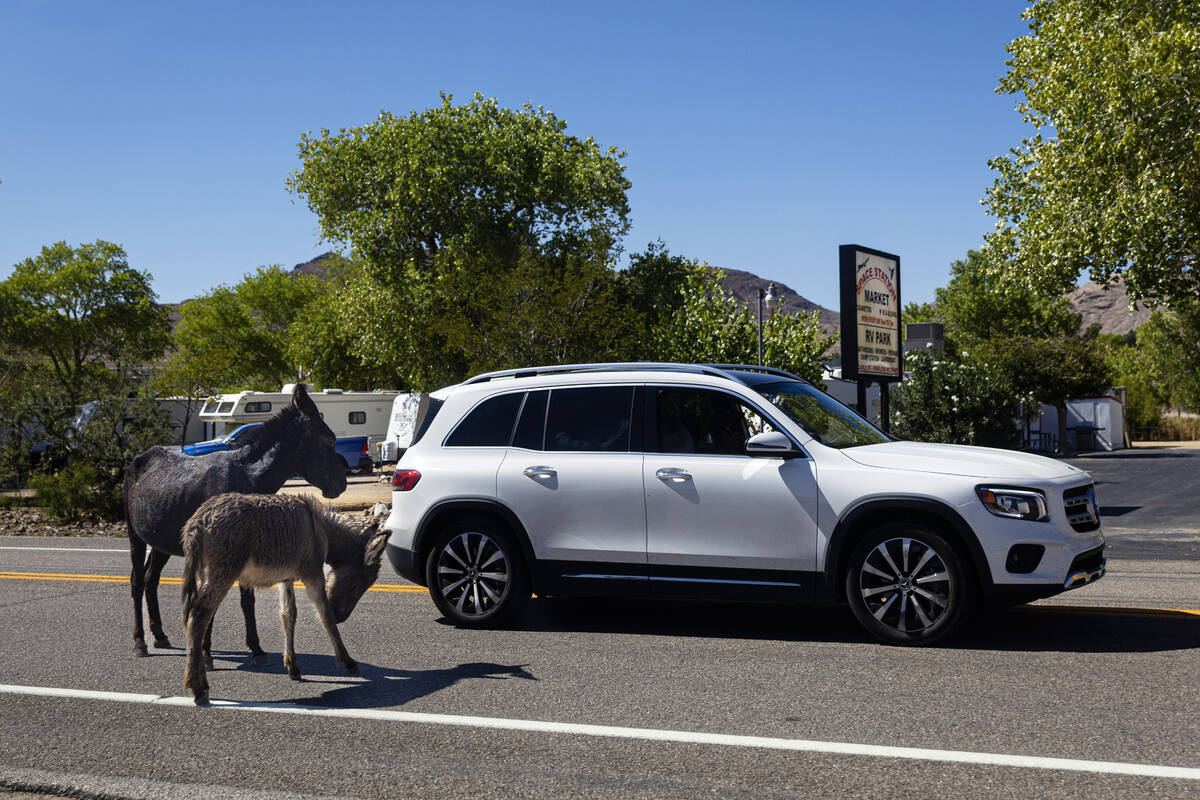In this Southern Nevada town, burros outnumber people — for now

These days, burros aren’t just Beatty’s unofficial mascot. They now outnumber people, digging through trash cans, causing traffic jams and getting up close and personal with gas station patrons en route to Tonopah.
It’s become a public safety issue in the town about 120 miles northwest of Las Vegas, according to the Bureau of Land Management, which conducted an emergency burro roundup Tuesday amid a federal government shutdown.
Nye County spokesman Arnold Knightly said it’s a common sight at a gas station parking lot for passersby to cozy up to the wild animals.
“They gather through trash, accepting snacks and posing for selfies,” Knightly said in an email. “I saw one guy wrap his arm around one like they were old pals, and another pet its nose like it was a golden retriever. They may be wild animals, but that parking lot is starting to feel like a petting zoo with a snack bar.”
In a news release, the BLM said it was removing about 250 of the estimated 1,197 burros within what’s known as the Bullfrog Herd Management Area, which surrounds Beatty in a swath of land that’s 18 miles wide and 14 miles long.
That particular herd management area is estimated to be able to support only between 58 to 91 wild burros, according to the federal agency.
Beatty has about 637 residents, according to a 2023 approximation from the U.S. Census.
A BLM spokesperson declined to give an interview or allow the Las Vegas Review-Journal to witness or photograph the roundup, emphasizing that it would be a bare-bones crew because burros are often reluctant to approach trapping sites when there’s too much activity.
Highway troubles
Stubborn as they may be, burros present a hazard on roadways, Nye County Sheriff Joe McGill said in a Tuesday interview.
The speed limit is 25 mph heading through town, so animals blocking traffic on the higher-speed U.S. Highway 95 on the outskirts of Beatty are more of a concern, he said.
A sheriff’s deputy hit a burro Monday near Pahrump, McGill said, which is an occurrence with some regularity. He said the majority of burro-related calls his department gets are related to traffic.
“A lot of people complain about the burros damaging their lawns, fences, sprinkler systems in their front yard,” McGill said. “They’ll go in there and chew, paw and dig stuff up.”
McGill said it was rare for the community itself to ask for a roundup. The Beatty Town Advisory Board has sent the BLM letters asking for a roundup every year since 2023, according to a town board spokeswoman.
The last time the BLM intervened in a significant way was in 2018 and 2019, when 1,094 were removed over the two years, according to BLM data. From 2023 to 2024, the area’s burro population increased fourfold.
Board Vice Chair Randy Reed told the Review-Journal that officials have noticed a boom in human interaction with burros. He attributes that to declining amounts of available food or water in the wild as the burro population has sharply increased.
The animals have begun to associate cars and people with food, Reed said, leading to far more car crashes than he’s ever seen. Burros easily become domesticated, hanging around the side of the road instead of spreading out in the wild.
“Burros are a part of our community,” Reed said in a statement. “We care about them, but the overpopulation that our local herds have been experiencing is not good for us or them.”
A point of controversy
Wild horses and burros, considered emblems of the American West, are some of Nevada’s most fiercely protected residents, with some advocates concerned about roundup tactics and holding facilities.
Nevada is naturally the center of the controversy, as well, as the home of half of the nation’s wild horses and burros, which roam its massive connected parts of public land.
In lieu of helicopters that chase horses and burros, Tuesday’s roundup used temporary corrals stocked with water and hay to lure the animals in. The Beatty burros will be trucked more than 400 miles away to a facility in Axtell, Utah, where they will be available for adoption through the BLM.
Amelia Perrin, a spokeswoman for the American Wild Horse Conservation nonprofit that opposes BLM’s roundup tactics, said the method from Tuesday is far more ethical than using helicopters that can scare the burros and chase them for miles.
Perrin’s organization advocates for the use of sterilization rather than roundups and sales.
In an interview Tuesday, Perrin brought up concerns about the Utah facility, where 45 burros died in 2023 because of health issues such as a blood disease often linked to stress-induced anorexia. Another 25 burros died at the facility in April because of disease, according to a BLM news release.
“The solution is not removal, but responsibility,” Perrin said in a statement. “By committing to coexistence through education and active management, we can safeguard both wild burros and the communities that cherish them.”
Contact Alan Halaly at ahalaly@reviewjournal.com. Follow @AlanHalaly on X.